Leadbelly
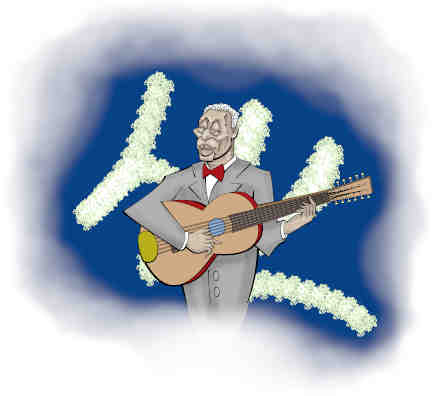
Leadbelly
(Click image to zoom in and out.)
In July 1933, John Lomax and his son Alan, visited the Louisiana State Penitentiary in Angola. John and Alan had been traveling throughout the South making field recordings1 of folk songs and had found that prisons were particularly bountiful repositories of African American songs handed down through oral tradition.
Footnote
A field recording in its broadest sense refers to a recording made outside of a recording studio. Among the earliest and most common usage was for recordings of music made among amateur musicians where they lived or worked. These might be people playing or singing in their homes or their churches, sitting on their front porches, working in the fields, and - although now largely vanished - inmates under incarceration.
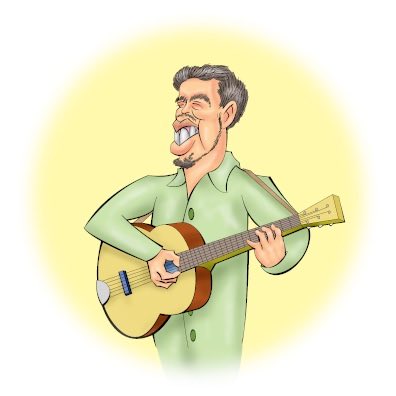
Alan Lomax
He and his dad met Huddie.
Among the prisoners whose songs they recorded was State Prisoner 19469, Huddie Ledbetter, singing and playing his 12-string guitar. Two of the songs he sang were "Angola Blues" and "You Can't Lose Me, Cholly."
Almost exactly a year later John and Alan returned to record more songs and specifically to record Huddie. After the Lomaxes had set up their new, high-tech, and massive direct-to-disk recording machine, Huddie had a new song ready:
In nineteen and hundred and thirty-two
Governor OK Allen, I'm pleadin' to you.
I left my wife wringin' her hands and cryin'.
Honorable Governor OK Allen, save that man of mine.
Had you, Governor O. K. Allen, like you got me
I'll wake up in the mornin', let you out on reprieve.
At the end, Huddie left a spoken message:
Now this song is composed by Huddie2 Ledbetter on Angola at Camp A, under Captain Rio, resident at Mooringsport, Louisiana, King of the Twelve String Guitar.
Footnote
In later years, Huddie's first name was almost always pronounced (even by Huddie) as "HEW-dee", although the usual rules for pronouncing English - whatever rules there are - would mandate a rendering as "HUD-dee" where the first syllable rhymes with "thud". On this recording, though, Leadbelly definitely uses the latter pronunciation.
According to Alan, he and his dad dropped a recording of the song at the office of Governor Oscar Kelly Allen in Baton Rouge. Although having served four years of a 6 to 10 year sentence for assault with intent to kill and whether because of this song or some either reason (as Alan put it), Leadbelly was paroled to his father a year later.
But (and it's a big "but") ...
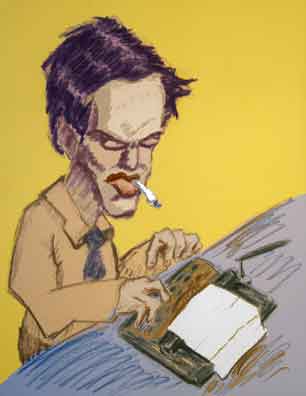
Alan Lomax
Actually Huddie was not paroled to John although for some reason John always believed he was. In fact, Huddie was not paroled at all. Instead according to the official records the release was based on accumulated "good time". That is, during his incarceration, Huddie had not caused problems and so his sentence had been reduced a certain number of days each month.
The story that Huddie "sang his way to freedom" remained a source of irritation to the Louisiana penal officials. Once when he was asked, the warden of Angola, Louis Jones, responded with a rather terse note:
This man has been the recipient of wide publicity in various magazines of national circulation, the story usually being that he sang or wrote such moving appeals to the Governor that he was pardoned. Such statements have no foundation in fact. He received no clemency, and his discharge was a routine matter under the good time law which applies to all first and second offenders.
L. A. Jones
Warden
And the truth is that Governor Allen had signed a good time release on July 25. Huddie was freed on August 1 only a few weeks after John and Alan's visit.
So again, another legend demolished!!!!!
Is there no romance left in the world?
Weeeeeeheeeeeelllllll, not so fast.
Unbeknownst to John, Huddie, under the name of Walter Boyd, had previously been an inmate in Texas. In February, 1918, he had been convicted of both murder and assault to commit murder. With two consecutive sentences levied, "Walter Boyd" was serving to 7 to 30 years as Texas State Prisoner 42738.
Huddie found himself at the infamous "Sugar Land" prison farm outside Houston. Like many prisons in the early 20th century, Sugar Land was an instrument for the continuation of the institution of slavery even though the statutory system had been long abolished.
The prison farms and mines were designed to produce a revenue for the state and turn a profit. To meet this end, there was also a system of convict leasing where convicts were hired out for work in private farms, businesses, and mines. Naturally the private firms made sure they minimized the cost (clothes, food, facilities) and maximized productivity (quotas, hours worked).
After disappearing for a time, in the early and middle twentieth century convict leasing has returned with a vengeance and is now a way for businesses to complete with cheap foreign labor. Prisoners may be - quote - "paid" - unquote - between 20 and 40 cents an hour, making possible nice, high profit margins. The consumer might be surprised to find out how many everyday items are produced by convicts whose work is leased to companies who outbid firms employing law abiding citizens.
But one difference from today's leasing system and those of earlier days was the amount of sheer physical brutality that was not only accepted, but was considered necessary. "Ain't nothin' better for a bad man than hard work" was the saying. They might have added "and hard thumpin'". Lee Simmons, the head of the Texas prisons from 1930 to 1935, openly said he believed in corporal punishment for all - in the home, in the schools, and in the prisons.
Although in some ways a leader in penal reform, Simmons was also on record in favor of the "bat" to handle the more unruly convicts. The bat, nicknamed "Black Betty" by the prisoners, was an officially sanctioned method of discipline, and was a 3 foot strap of hard leather attached to a wooden handle.
The standard procedure was to spread-eagle the stripped prisoner face down on the ground, and while being held by other prisoners, beat him repeatedly. Naturally serious and even life threatening injuries were common when the prisoner's skin would be ripped open exposing the muscle. The regulations stipulated all instances of corporal punishment be noted, and defenders of Simmons' records point out that in his first year, there were only 80 cases of physical discipline in the entire Texas prison system. That was over a 40 % drop from the previous year.
But the truth is that the official number is ludicrously low and lots of physical punishment was never recorded. Prisoners would be beaten for the smallest infractions: failing to make quotas, not keeping up with the work, falling behind when running to and from the fields, or simply to set an example for new prisoners. One common infraction was showing intransigence or disrespect. On one occasion Huddie was given fifteen lashes for "impudence"3.
Footnote
In fairness to the correctional officers who tried to do their jobs honestly, there was considerable variation in how individuals handled the prisoners. Charlie Berta, one of the early prisoners on Alcatraz Island, said in an interview that there was no brutality on the island. Most guards were professionals who followed the rules. But there were exceptions. "The one that hit me on the head," Charlie said, "he was no good."
Huddie had little hope for getting out. Following World War I, there was a get-tough-on crime push. In particular, Pat Neff had been elected on a promise of no pardons.
Then in January 1924, on one of the governor's tours of the state, he and an entourage of officials and their wives were entertained by the prisoners. Huddie - still known as Walter Boyd - had a reputation as a musician and would perform for other prisoners on Sundays. The warden summoned Huddie who played a concert for the men and the ladies.
And yes, one of the songs Huddie had sung was:
In nineteen and hundred and twenty three
When the judge took my liberty away from me.
If I had you, Governor Neff, like you got me.
I'd wake up in the mornin', I would set you free.
Neff, who had met Huddie on previous tours, was impressed at what seemed a spontaneous musical plea (actually Huddie had spent hours crafting the lyrics). He told Huddie - who somewhere along the line had picked up the sobriquet of Leadbelly - that he would set him free someday. "But I'm going to keep you here so you can pick and dance for me when I come down."
Huddie was hopeful, but the other inmates discounted any such promise. You could bet that as soon as the Governor left, he'd forget anything about any pardon.
But on January 16, 1925, - four days before he left office - Pat Neff signed a full pardon for Walter Boyd. The governor, though, was clearly playing it fast and loose against any accusations he was welshing on his campaign promise. Huddie had almost served the minimum of the sentence.
So the story of Leadbelly singing his way to freedom is true and false. It just a matter of which prison and governor you're talking about.
Huddie Ledbetter was indeed born near Mooringsport, Louisiana, to Wesley Ledbetter and his wife Sallie (née Pugh) in 1888. A commonly listed birthdate is January 23, but Huddie always said it was January 15. The place of birth is listed as the Jeter Plantation. Before the Civil War this massive holding was owned by William and James Jeter, and after the war and although the plantation slaves had been freed, most continued working for the Jeters4.
Footnote
One way to keep slavery in disguise was the system of debt bondage. Until the crops came in, the share croppers had to live on credit from the local stores which were often run by the plantation owners - the so-called "company stores". Cash transactions were not needed but a tally was kept of what the family owed.
After the crop came in the amount the harvest realized was credited to the debt. It became a common and deliberate practice to juggle the books so that the debt was never quite cleared. So the farmers couldn't move away even if they wanted to. Interestingly, debt bondage was also common in the early days of the Roman Republic. But it was abolished in the fourth century BCE.
Sometimes the shoe was on the other foot due to a similar practice called "the consignment system" particularly during the colonial era. Rich landowners would buy fancy items from England and pay for the purchases by having their broker use the proceeds from the plantation crops. But they inevitably found that the produce never quite covered the cost of what they bought and they found themselves falling further and further into debt. One gentleman who fell prey to this system and ultimately switched to buying and selling locally was a young farmer named George Washington.
Huddie - originally spelled "Hudy" - was Wes and Sallie's only child but they adopted a baby girl, who they named Australia. Huddie said that his parents were particularly nice and even spoiled him. Most rare for the day, they never used corporal punishment.
Mooringsport is in the extreme northwest corner of the state and not even five miles from the Texas border. It's situated on the south shore of Caddo Lake. The lake was originally formed behind the Red River's "Great Raft" which was a massive 120 mile long log jam which choked up the river and made it unnavigable. The jam was finally cleared by the US Army Corps of Engineers before the Civil War. Later an artificial dam was built which forms the modern Lake Caddo.
Most people would say that Leadbelly was born into a poor family. But actually Wes was considered part of the African-American middle class. Wes had been working on shares for a wealthy African American landholder and a few years after Huddie's birth, he managed to buy 70 acres of land for $175. Wes's farm was actually across the state line in Harrison County, Texas.
Huddie either dropped out of school around age 12 or finished the eighth grade depending on the source. In any case - again if we look at the standards of the day - that was par for most kids, white or black. In 1900 only about 10 % of the kids were going to school. A - quote - "good education" - unquote - might stop with grammar school (grades 1 through 8) and at age 14. High school was something for the posh kids.
One thing Huddie had was a talent for music. He had played in the school band (accordion) but it was his Uncle Terrell who introduced him to the guitar. That was the instrument for him. It was some time later that he bought a 12 string.
The twelve string guitar is what's called a double course instrument. Yes, there are twelve strings but these are strung in pairs. The strings of each pair are close enough together so you can press both strings with only one finger. So the instrument can be fretted as the standard six-string guitar.
The course of the first three strings - E, B, and G - are in unison - that is they play the same note. The "lowest" strings - D, A, and E - which are physically the uppermost strings - are tuned in octaves. The three lowest strings are the usual pitch of the six string guitar and their paired strings are an octave higher.
The twelve string has a full "choral" sound but because three of the "bass" string are an octave higher than on the standard guitar, the twelve string guitar has a treble and ringing sound.
But for Leadbelly the virtue of the 12-string was its power. It produces loud yet nevertheless pleasant music, perfect for those non-electric and non-amplified days.
With a pocket full of songs - some were learned from Uncle Terrell - Huddie began playing for local dances. Musicians were in demand because this was when 1) dancing was a popular pastime and 2) good music had to be live music. Some of the dances might pay a bit upfront, but otherwise the custom was for the performers to "pass the hat". Also the musicians got free food and drinks.
Which caused some problems. Young hormone filled men and women letting off steam from a week of hard work plus plenty of alcohol was not a good recipe for tranquility. Fights were common and at times with tragic outcomes. Alan Lomax mentioned that when he visited the Appalachians in the 1930's square dances had pretty much disappeared because so many people had been killed at those "drunken blowouts".
The musicians themselves were sometimes the unwitting cause of discord. The young ladies liked to go up and watch the musicians play and they would chat between songs. This was often to the irritation of the boyfriends and husbands. And Huddie wasn't shy. If a lady wanted to be friendly, it was rude to be stand-offish.
These were also rough times. It's sometimes forgotten that Huddie's childhood was technically still the time of the Old West. He was seven years old when the Daltons robbed the banks at Coffeyville, Kansas, and eight when Bill Doolin was killed by Marshall Heck Thomas in Lawson, Oklahoma. Men often went around armed and even as a teenager Huddie usually carried a pistol.
After one of the dances Huddie decided to take a young lady name Eula home. But another suitor stepped up and said he was going to take Eula home. Naturally a discussion ensued which ended up with Huddie hitting the young man with his pistol and then pinning him down. As this situation seemed to be a stalemate, Huddie pointed his gun and pulled the trigger.
Fortunately, the gun misfired. The rival for Eula's affections, who realized he wouldn't be taking Eula home, jumped up and ran. Immediately Huddie realized what he had done wasn't really that smart. So after dropping Eula off at her farm, he returned home and told his dad what happened. Wes decided they should report the matter to the authorities.
But the parents of Huddie's rival had already called the sheriff. But the sheriff knew and respected Wes and only charged Huddie with carrying a concealed weapon. Huddie was fined $25 and let go.
Huddie did have trouble controlling his temper and he continued to carry a pistol - not a good combination. Shortly after this first altercation, he happened to glance through a window of the house of another young lady friend. Angered when he saw she was sitting talking with another young swain, Huddie pulled his gun and fired through the door. Again nothing came of this incident except the sheriff paid Huddie another admonitory visit.
We see then that although Wes and Sallie were among the most respected of Shreveport's African American community, their son was getting the reputation of being a ne'er-do-well. The censure was not just from Huddie's improvident temper but also because with his plethora of girlfriends, there were some, well, "issues" of the relationships. With the citizen's censure plus a natural desire for any teenager to get out of the house - Huddie was only 16 in 1903 - he turned his eyes toward the "big city".
Only twenty miles from Mornginsport was Shreveport. And in Shreveport you had the notorious Fannin Street. Today Fannin Street moves through residential areas and into the city and bordered with office buildings and parking garages (it's also is the home of the historical Holy Trinity Catholic Church). But its genteel appearance masks its history. In Huddie's time Fannin Street was where you went for a good time. And we mean a good time.
Singing on the streets, at dances, and wherever he could set up, Huddie became a figure in Shreveport. But he also began showing a restlessness and for a couple of years during the summers he headed out to do itinerant farm work.
Unfortunately, things didn't go smoothy. While on his travels he came down with what his polite biographers called an "illness". So he returned to the family farm. Although he nearly died, the doctor was able to cure the malady.
Huddie himself realized his lifestyle was not really a healthy one. So in 1908 and nearly age 20, Huddie made an honest attempt to settle down. He married a young woman named Aletta who everyone called Lethe. Huddie later said he also attended the nearby Bishop College and for a brief time - very brief - he became active in the local church.
The sad fact is that Huddie's try at a conventional lifestyle was short lived. He continued to sing and play at dances which were environments no less contentious than before. And Harrison County had its limits for advancements. Around 1910, Huddie and Lethe relocated to Dallas.
The couple settled near the intersection of Elm Street and Central Avenue - in an area called Deep Ellum. Although not as unabashedly an area for entertainment as Fannin Street, Deep Ellum was still a place with plenty of attractions for Huddie and his guitar.
It was in Dallas that Huddie bought his twelve string Stella. Stellas were unusual in that they had a fretboard almost an inch longer than standard guitars and so were tuned about a step lower. This produces a fuller sound than you hear on other instruments. One of the songs he adapted to the new instrument was "Irene" which became his signature song.
At that time Dallas was the big city. It had more people than Houston. And there Huddie met one of the most famous bluesman in history. That was Lemon Henry "Blind Lemon" Jefferson.
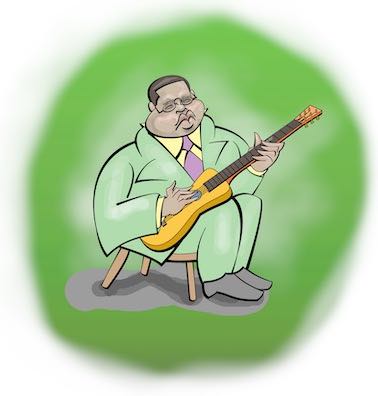
Blind Lemon Jefferson
He played with Huddie.
Huddie said it was Blind Lemon who really taught him how to play. Lemon would be on the streets each day busking the blues. He was always singing. Even when he quit for the day, he'd lay in bed and sing.
People who knew him said Lemon was not completely blind, and he did wear regular glasses (not shades). So he probably had what today we'd call impaired vision.
Huddie and Lemon joined forces and played at various functions. They were actually making a pretty good living at it, at times taking in $150 for a weekend. Lemon played what was then called "Hawaiian" guitar - holding the instrument face up and playing with open tunings. Huddie said Lemon taught him how to play slide.
Huddie could supplement his income by taking odd jobs, but Lemon had to make his living with his music. He'd play on the streets, he'd play for dances, and he'd even play in churches when he wasn't playing in - well, let's say he also performed in establishments dedicated to gentlemen's special interests. It wasn't for another ten years that Lemon began to gain national attention with his recordings.
The reason for the recording boom was the introduction of electric recording. Earlier recording technology had been mechanical. Sound vibrated a diaphragm where an attached needle cut a groove into a record "blank" - either a cylinder or a disk. But the sound was unamplified and it sounded like the musicians were three miles down a two-mile tunnel.
But with the invention of electrical sound systems, the signal could be amplified - both during recording and during playback. Starting in 1925 the sound of records was not that far from modern quality. Suddenly good music no longer had to be live music.
Record producers scoured the country for potential stars. The categories were varied and diverse. There were classical and popular genres of course, but you also had country music - then called "hillbilly" - and music of the African Americans - called "race" records. The major companies had no hesitation marketing for the latter audience, either. If the record producers could make a buck, they'd produce it.
Recording Stars

Alberta Hunter
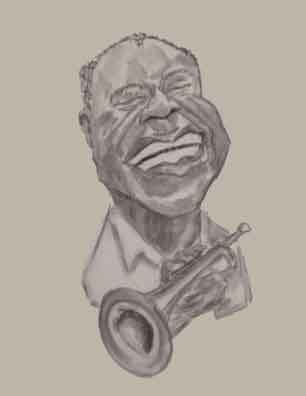
Louis Armstrong

Bessie Smith

Duke Ellington
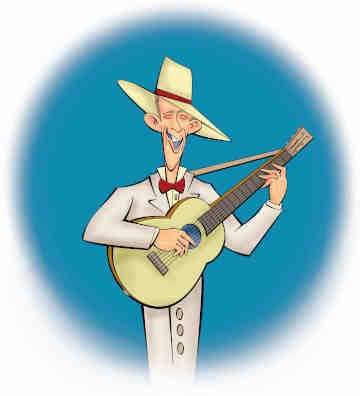
Jimmie Rodgers
Among the recording stars that emerged between 1915 and 1930 were the legendary names. There was Blind Lemon Jefferson, of course, but also Ethyl Waters, Alberta Hunter, Louis Armstrong, Jelly Roll Morton, Rainey, Bessie Smith, Duke Ellington, Uncle Dave Macon, Cab Calloway, his sister Blanche, Charlie Poole, Fiddlin' John Carson, Gid Tanner and Riley Puckett and the Skillet Lickers, Big Bill Broonzy, Scott Joplin, Maurice Chevalier, King Oliver, Jimmie Rogers, Cajun singer and accordianist Joe Falcon, Son House, Mississippi John Hurt, Irish tenor John McCormack, Sleepy John Estes, Memphis Minnie, Charle Patton, Josh White, and Rudy Vallée.
But hold on, there! Didn't you leave out Huddie Ledbetter - our Leadbelly?
Uh, no. From 1918 to 1934, Huddie had, well, other things to take up his time.
In 1915, Huddie and Lethe moved back to Harrison County to be near his folks' farm. Wes and Sallie were getting up in years and Huddie and Lethe could help them work the farm. Also they were slated to inherit the land which would set them pretty well up.
Then Huddie was arrested. The official conviction was for possession of a pistol. However, there must have been more to it since possession was a minor offense. Instead Wes and Sallie went to a local father-and-son law firm and for lack of cash deeded their land for them to defend Huddie. Most likely, the incident involved Huddie's always hard to control temper and might have involved assault with a weapon.
But whatever the original charge was, the attorneys ended up garnering what seems like a light sentence. Huddie landed 30 days.
But not 30 days in the local jail. Instead Huddie got a month on the county chain gang. Evidently the stories of this involuntary servitude was such that Huddie decided from the first he wasn't going to stick around.
After three days, Huddie was gone. He had realized that if he could get to the woods, he could shake off the pursuit. So during the day he eased himself over to the edge of the fields.
Then chains in hand, he ran. With the bullets kicking at his heels, he reached the woods. He covered his tracks by crossing and wading in streams and he managed to throw off the bloodhounds.
Finding a group of men clearing a field, he had his chains cut in two (which probably ruined the axe beyond repair). Then he made it to his parents' house. After hiding Huddie for two days, Wes and Sallie managed to put him on a train bound for New Orleans. But for whatever reason, Huddie soon returned to the farm. He picked up Lethe and moved to De Kalb, a town in Bowie County, Texas, about 70 miles northeast of Mooringsport.
There Huddie assumed the name Walter Boyd. Not being that far from Harrison County, he decided to put his 12-string aside. That would tip off the authorities for sure. One positive note was that a lot people in Bowie County knew who "Walter" really was and could be trusted to keep mum.
But again his love of a good time plus his temper - whether he was Huddie Ledbetter or Walter Boyd - caused him trouble.
Huddie just could not give up music. Soon he was back to playing his guitar at dances and in barrooms. Although this action seems to be reckless in the extreme, the truth is that after a while the Harrison County authorities lost interest in a minor offender who had gotten away from a 30 day sentence.
So gradually Huddie returned to his preferred way of life. Working the fields during the day and the week, playing guitar and having a good time at night and on weekends. But the dances and barrooms could still be dangerous since sometimes what started out as simple joking and "hoorawing" could make tempers flare. There were a number of incidents where Huddie got into trouble with men and women. But then one incident turned out about as bad as it could get.
On December 13, 1917, Huddie had been living as Walter Boyd for two years. That night he was walking back home from a dance with three other men. One was Will Stafford, a distant relation by marriage, and who Huddie later said was a friend. Will, though, had a reputation as a tough guy with a fractious and cantankerous personality.
Friend or not, relative or not, for some reason, hard words passed - once more probably due to a rivalry for a young lady's attentions. At one point Huddie pulled his pistol and fired. Whether it had been Huddie's intent or not, Will fell dead.
Sometimes people hope if you ignore a problem, it will go away. Evidently that's what Huddie and his surviving friends did. But a couple of kids strolling down the road the next day and coming across Will's body felt it wasn't something that could be ignored. They called the sheriff. A little investigation led them to Mr. Walter Boyd.
Naturally Huddie couldn't afford a lawyer and now neither could his folks. So the court appointed a local attorney who seems to have done as best a job as he could.
After a one day trial, Huddie ended up with a sentence of five to twenty years. The United State Constitution mandates a speedy trial, but that was ridiculous. Also before the trial Huddie sat on ice in the county jail for six months. Then after the first trial (for murder) he was tried for the second charge which was assault to commit murder. That got him a consecutive sentence of two to ten. So Huddie was going to be spending from seven to thirty years in the penitentiary.
Huddie was first sent to Shaw Prison Farm only about ten miles from De Kalb. It was a horrible place. Hot and sweltering, Huddie spent his days in the fields. Brutality was the rule and beatings were inflicted for the most minor of infractions.
After a year, Huddie had enough. On August 15, 1919, he and another convict slipped into the woods. His companion soon fell behind but Huddie pressed on.
His freedom was short lived and soon the sheriff came across Huddie resting by the banks of a lake along the Red River. He ordered the exhausted Huddie to come along. But Huddie just stood up and walked into the water.
Sending the dogs had no effect. Huddie wasn't going to go back to prison. But after Huddie went under, the posse managed to pull him out of the water. He was almost dead but they revived him and took him back to camp.
The prison officials must have seen something different about the prisoner they knew as Walter Boyd. Instead of reprisals for his escape, the section supervisor kept him out of the fields and let him rest for a week. Huddie then decided that bucking the system was getting him nowhere. The only way to get out early was to win a parole. So by the time the governor came on his famous visit, Huddie had become a model prisoner.
After Huddie sang his way to a pardon, he moved briefly to Houston. And yes, he continued his rambunctious ways and had a number of minor altercations with the police. But the infractions weren't too serious and sometimes the cops would take him to the stationhouse just to listen to his music.
But back home his father had died and his mom was on her own. So Huddie moved back to Shreveport where he heard the oil industry had created good jobs for everyone.
Music had changed during his years in prison. People were listening to the blues and with the Victrola becoming affordable they could so so in the comfort of their own homes. His old partner, Blind Lemon Jefferson, was now selling records like crazy (although how much he received in royalties is questionable)5. Radio was also a booming entertainment industry. Instead of getting up every three minutes and changing the record you could turn your radio on, sit back, and listen to music all evening.
Footnote
Even a hundred years after Blind Lemon was recording, the question of how regularly royalties are paid can be a touchy subject. One of the most well-known folk singers with a Grammy to his credit quit recording for a decade since the royalties paid has been suspiciously sparse.
Again Huddie fell back into his usual modus vivendi. While he was at Sugarland, Lethe had the marriage dissolved and so Huddie was a single man. But he was no longer a youth who could plead high spirits if his temper got the best of him. He was a middle aged 41 and having to make a living.
The reports of the good jobs in Shreveport were overblown. The specifics of how he managed aren't clear but probably he did a little of everything from farm work to driving a truck. He also made some money making moonshine.
With Lethe gone, Huddie soon set up housekeeping with a young lady named Era, and his mom, Sallie, was now quite elderly and lived with them. Huddie still liked going to dances and parties as did Era. But these entertainments had not become more genteel. Once he was playing at a party and a man came up and stabbed him in the neck. A second man came forward with a pistol. Era jumped into the fray and managed to fend off the pistol-wielder.
We have to admit it. Trouble seemed to find Huddie even if he wasn't looking for it. And trouble really found Huddie on January 15, 1930. As with virtually all of Huddie's encounters with the law, it's not clear what actually happened. The accounts don't even come close to agreeing.
One story - from a friend of Huddie's - was that the local high sheriff had seen Huddie walking on the sidewalk. That, the sheriff thought, was a privilege only for white people and Huddie should be walking in the road. When Huddie didn't step aside, the situation got confrontational. Then a white man named named Dick Ellet came along and somehow got involved.
Another story, which is what one newspaper reported, was that a Salvation Army band had been playing a concert and Huddie was standing by listening. As the band continued playing Huddie seems to have become wrapped up in the music and began dancing or perhaps keeping time in a distracting manner. Evidently Dick Ellet and several others intervened and accused Huddie of disrespect.
Then there's a third story. Huddie was simply butchering a hog at his home when Ellet came along. Some disagreeable remarks passed that resulted in an altercation.
But whatever happened, Dick Ellet ended up in the hospital with "severe cuts" inflicted with a knife. Huddie was arrested and put in the local jail.
Things quickly took an ominous turn. A mob gathered and attacked the jail. Fortunately, Caddo Parish county sheriff Tom Hughes and other officers managed to stand the men off. After a while it was clear that Ellet's wounds were not life-threatening and things simmered down. But Huddie was in real trouble.
Like the trial of Walter Boyd a decade earlier, Huddie's trial for assault to commit murder took only one day. It ended with Huddie sentenced from six to ten years. On February 27, 1930, Huddie arrived at the Louisiana State Penitentiary at Angola.
It's interesting that no matter when you read a story about Angola Penitentiary it always tells how the tales of brutality are from years past. Now we hear it is a model prison with the focus on rehabilitation complete with its own newspaper and radio station. Perhaps.
But what isn't in doubt is that in Huddie's day it was a hellhole. From 1928 to 1940, there were over 10,000 floggings admitted by the authorities. In 1933 alone, there were an average of 4 floggings a day of fifteen "recorded blows of the double lash". That's the average. In one case an inmate was flogged until the guard got too tired. He then handed the lash over to another guard who continued until he also got tired. Then the first guard took over again and continued.

Huey Long
He wanted to save money.
The goal was to have the prisons not only to cost the taxpayer nothing, but also to make a profit. So to save money, Governor Huey Long had cut down the number of paid employees by over 60%. To make up the dearth, Huey' officials established the trustee or "convict guards" system.
The convict guards were armed prisoners who served in place of correctional officers. The trustees received some pay as well as extra and better food. But most of all they had special privileges which included seeing women visitors in private. The convict guards would receive extra bonuses if they shot prisoners trying to escape.
Huddie didn't escape the brutality. Once he was given ten lashes for "laziness" and at another time fifteen for "impudence". On the other hand, Huddie was not a troublemaker by nature and he was eventually moved from full time work in the fields to serving as a waiter in the mess hall and as a worker in the tailor shop.
Although there were no fences or walls around the prison fields, escape was virtually impossible. The land was surrounded on three sides by the Mississippi River. To get to the other side you had to swim half a mile in the fast flowing current. Huddie didn't even think about escape. He decided to work within the system.
Prisoners could receive packages, and Huddie managed to get his Stella. He quickly acquired the reputation as one of the best "songsters" at the prison. On Sunday he would entertain the other prisoners and - as we saw before - the visitors.
But to get his freedom the only real option was to obtain a commutation, and Huddie filed a formal request with the parole board. Huddie was ecstatic when the parole board wrote that he would free in June 1934. That was only a year away.
But as time went on Huddie heard nothing. He wrote again to the parole board.
Now he was told that no, he couldn't be released early after all. He was a second-time offender (the authorities knew about "Walter Boyd" and his murder conviction). He would not be eligible for parole until 1936 after he served the minimum of his sentence. However, it was possible he could receive a pardon if he requested it and the governor approved.
The in another reverse - this was state bureaucracy after all - Huddie was released on August 1, 1934, almost exactly when he was first told. This was neither a commutation or a parole, but because of the "good time" rule. The caveat was that if Huddie got into trouble and was convicted for another crime in Louisiana, he'd have to finish serving his original sentence before the clock started ticking again.
But not everyone was satisfied with how the wheels of Louisiana justice had turned. When Tom Hughes, still the sheriff at Caddo Parish, heard that Huddie had been freed, he wrote a rather grumpy letter to the general manager of the prison system, Robert Himes. Was it true, he asked, that "Led Better", the man who had attempted to murder Dick Ellet - "a splendid white citizen" of Morringsport, according to Tom - had been in fact released? Yes, Himes wrote, he had.
Huddie, of course, was delighted. After some hesitation, he returned to Shreveport, determined to keep out of trouble. It really helped that he soon set up housekeeping with a young woman named Martha Promise. She had known Huddie in his younger days and although she was a regular churchgoer she was happy to take him in.
However, 1934 was the worst year of the Great Depression. Fourteen million men were out of work - about 25% of the population. And times were particularly tough for two time ex-convicts who had been convicted of murder.
Then remembering the folk songs collectors who had come to Angola, Huddie hit on one of the best ideas he had ever had. He obtained John Lomax's Austin address and he wrote him offering to serve as his driver and all around mechanic. John knew of Huddie's general ability and it seemed like a good idea. Huddie could also serve as a liaison, not only with the prisoners they wanted to record, but also with the African American communities in general. He wrote back and asked Huddie to meet him in Marshall, Texas. This was convenient for Huddie since Marshall is only about 35 miles west of Shreveport.
John, Huddie, and later with Alan traveled around the South. Logistics could be a problem particularly where to eat and sleep since segregation was in full force. They had to look for accommodations that would accept anyone by race (virtually impossible) or by finding separate accommodations for Huddie (who often stayed with local black families). Sometimes they would simply camp out by the side of the road.
Huddie didn't seem to mind. In fact he seemed to be having the best time of his life. If John had business to attend to, Huddie would head to the local black section of the town, make friends, and play and sing. Then he'd return and they'd head back out on the road.
Huddie was particularly valuable when they would visit prisons. He would play a tune to show the men what type of songs they were after. This would break the ice and it was generally no problem to get the best musicians to record. The main problem was the cantankerous recording machine which took up the entire trunk of the car and kept breaking down.
The first trip had lasted about two months and Huddie was back with Martha in Shreveport in October 1934. But he didn't have long to sit around. In early November, Huddie got a letter from John proposing a new trip. They'd stop by some of the southern prisons to record some more songs. But then they'd wind their way north to Philadelphia. There Huddie would sing for a bunch of - yes - college professors.
The meeting of the Modern Language Association was held at the Benjamin Franklin Hotel on Chestnut Street - now a fancy apartment building - about half a mile east of City Hall. Although sometimes seen as a Southern phenomenon, segregation was rampant in the North as well, and Huddie had to find separate accommodations.
The news had gotten out that the entertainment was going to be unprecedented, and before the performance, a reporter for the Philadelphia Independent, an African American newspaper, interviewed Huddie. As in almost every story about Huddie (then and now) the article mentioned how he had been convicted of murder and sung his way to freedom.
What can be considered as Huddie's first real concert was December 18, 1934 at the Crystal Ballroom of the Benjamin Franklin Hotel. Officially this was the "dinner and smoker" of the meeting, that is, an informal get-together before the boring talks began. But it was a big crowd - 1500 people - and most of them were indeed college professors.
Huddie wasn't the only performer. Professor Mary Hoston of Haverford College sang some Elizabethan madrigals and her husband led the group in some sea shanties. There were a couple of talks, one by Majorie Nicholson, Dean of Smith College.
But the highlight was Leadbelly and his songs. Everyone agreed he was in top form and after his performance was over, he received a standing ovation. As was the custom, he passed the hat.
A second performance was also a success and in the program he was billed for the first time as "Leadbelly". Again he passed the hat. The total for both appearances was $47.50.
There was yet a third program set up for Bryn Mawr, the prestigious women's college. Whether because of the nature of the songs such as "Who, Back, Buck":
Whoa, buck, an' gee by lamb!
Who made the back-band?
Whoa, goddamn!
..., the song sometimes politely spelled as "Dick Liquor's Holler", or simply the fact that the audience was much smaller, Huddie only realized $10.
But then there was New York.
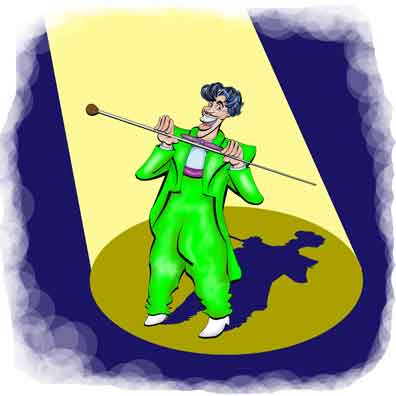
Cab Calloway
A different style.
Huddie and John had been scheduled for a performance sponsored by Columbia and New York Universities (passing the hat netted Huddie $14). But Huddie immediately saw that this was the town for him. With a night off he headed to Harlem where he visited the famous Cotton Club. He later said that Cab Calloway had offered him a job (although Cab really played a different style). He had such a good time that he missed an interview scheduled for next morning at the Herald Tribune. So John, rather irritated, had to sit for the interview alone.
And through no fault of John's the reporter focused on the rough side of Huddie past, saying how "the Sweet Singer of the Swamplands" was "here to do a few tunes between homicides". Of course the story mentioned that the singer "has sung [his] way to 2 prison pardons".

Rudy Vallée
Huddie auditioned.
Although both John and Alan hated the write-up's sensationalism, the story brought Huddie to national attention. NBC executives asked if Huddie would audition for Rudy Vallée's radio program "The Fleischmann's Yeast Hour". This was the first time that John ever saw Huddie nervous and in the end Rudy decided to not feature Huddie.
But almost immediately they got an offer to be featured on the "March of Time" radio program on CBS. Originally the producers planned to use actors but the audition convinced them that Huddie and John could play their own parts. Here Huddie seemed fine. He sang his songs and delivered his lines with no problem. So Huddie's story was now familiar to - literally - millions of home all across America.
All sorts of feelers were being sent out by record producers, theatrical managers, and impresarios. So John and Huddie signed an agreement where John would be his manger and they would split all money 50/50. Normally this seems to be a lopsided arrangement against Huddie - agents usually get 10% - but John was also the emcee, road manager, booking agent, financial planner, and publicity agent6.
Footnote
Of course, Huddie was also the main act and performer, composer, arranger, driver, and mechanic
But things weren't shaking out and there were no offers that John thought worth pursuing. Also at the relatively advanced age of sixty-eight he was getting worn down. Leadbelly was also getting a bit tired of the grind and he was fully on board when John suggested that Martha come up from Shreveport and join them. This was asking a lot of her but Martha agreed and although Huddie was almost thrown into panic when she didn't get off the scheduled train (she had in fact arrived early and was waiting in a side room), she reached New York after a trip of over thirty-six hours.
Huddie and Martha were married on January 20, 1935. Huddie wore a double breasted suit complete with white gloves. Alan was the best man. Naturally the story was covered in the newspapers.
As a way to get a little peace and quiet John, and Alan along with Huddie and Martha stayed in Wilton, Connecticut, as guests of Mary Elizabeth Barnicle. Mary was a professor at New York University.
In some ways the location really wasn't that convenient as it was almost 50 miles from Manhattan. But it was suitable for John to write the two books that had been contacted by MacMillan Publishers. One was about his adventures collecting folk songs and the other was to be a collection of Leadbelly's songs.
One recording company that expressed an interest in Huddie's songs and the one that John and Huddie signed with was the American Recording Corporation (later Columbia Records). Huddie was to record forty songs and the deal was fairly standard: 2¢ royalty per record with the first $250 paid in advance.
The records, though, didn't sell very well. In fact, the sales were rotten. The ARC executives were surprised but the problem was they didn't really understand Huddie's music.
Huddie had no special genre of songs. Had he specialized in the blues as did Blind Lemon Jefferson, he probably could have sold more records. Even when Huddie moved on independently of John and Alan, he kept with his broad repertoire.
There was still a lot of interest in Leadbelly by the news people and the producers of the March of Time radio show decided to put out a newsreel. Again Leadbelly and John would play themselves.
The filming began February 8, 1935, and stretched over a week. Today the film seems stilted and corny even though Leadbelly did a quite creditable job, particularly since in those early days of cinema pretty much all acting was stilted and corny.
It didn't help that the script itself was stilted and corny and the director was intent on keeping things that way. When John tried to change the dialog to sound more natural the director would stop and insist on reading the lines as written. We also have to admit that the plot seems intent on catering to the 1930 stereotypes. But historically it's a film worth viewing.
John and Huddie were having a good number of bookings which would pay anywhere between $50 and $100. Huddie also would pass the hat (we don't know if they split the cash here). In March they had a series of performances throughout New York and New England. Huddie was a particular hit with the college kids.
But there was starting to be clear strain between the two men. John was worried how Huddie liked to go out on the town, and Huddie was getting tired performing in his bib overalls and bandana. But most of all, Huddie resented the way that John was "protecting" him by controlling the money. Sometimes when Huddie asked for some cash, John refused.
Finally Huddie went out and with his cash on hand he bought a new suit. He then walked in to where John was writing.
Huddie demanded his money. He said he would sing what he wanted to sing. And he was calling the tour off unless Martha could come along with them to the concerts rather than just staying in Connecticut.
During the confrontation John had actually been scared. But afterwards he just got angry. In a letter to his wife he complained about Huddie's "ingratitude". Nevertheless, the tour continued.
Things remained tense. In Albany, Huddie was supposed to play at a large party at the home of some of John's friends. But Huddie simply sat in the kitchen talking to and playing the guitar for the hosts' twelve-year-old daughter. She and Huddie had a fine time but John was fuming.
When Martha showed up, things simmered down. Finally John arranged a concert at his old school, Harvard. The Brahmin audience, which included the famous Shakespearean scholar George Lyman Kittredge, stood for an ovation. The Harvard paper, the Crimson gave Huddie a five-star review.
The tour finally ended on March 26 when Huddie and Martha got on the bus for Shreveport. Although the amount Huddie earned - minus expenses and the 50/50 split with John - was only about $300. But that really wasn't too bad. Its modern wage equivalence is about $15,000 and was certainly enough to tide Huddie and Martha over for a while. John gave Huddie half in checks and half in cash. But Huddie did have to pay for the bus tickets.
Back in Shreveport, Huddie had a surprise. When he got to the bank, he learned John had post-dated the checks. The banks said they couldn't cash them until the stipulated date.
Now it was Huddie's time to get ticked. He wrote to John about the money. We don't know what was in the message but immediately John wrote to Tom Hughes, who was still sheriff in Caddo Parish. He said that Huddie had threatened his life over the checks. He wasn't asking for any action but wanted to know if Sheriff Tom thought Huddie should be sent the cash.
John then explained to Tom what happened. He had been afraid that if Huddie was given the $300 as cash in hand, he would go out and spend it all on high living. So he had postdated each check about a month apart to keep Huddie's cash flow more temperate. He had explained this to Martha and she had no objections.
Despite John's nervousness, Huddie was not making any physical threat. He said he needed the money immediately because of the expenses he had incurred. John was getting tired of the hassle and Huddie got his money.
Pleased with the outcome, Huddie then asked about any money owed him for royalties. He soon got another surprise.
It seems that the recording contract had been signed only by John. Admittedly this was a common practice. Usually after an agent struck a recording deal, he would then pay the musician a lump sum in advance from his own pocket. Then when the royalties came in the agent would keep the money to pay off the debt. The idea was the musicians probably would prefer a goodly sum at once rather than have the money come in as dribs and drabs as the records got sold. In most cases this was correct, but it was also not easy for the musician to keep tabs on what was due when new money came in.
John was not deliberately trying to take advantage of Huddie and really thought he was acting in Huddie's best interests. He had come to believe that Huddie had been specifically paroled to him and that the singer was his responsibility. But now with Huddie's recently asserted independence, John asked ARC records to send royalty statements to Huddie and Martha so they knew what was properly their due.
But it really didn't matter. In the end ARC actually lost money on Huddie's records. After all, it would have taken 12,500 records to earn royalties to cover the $250 advance. The sales didn't come close to that - maybe a couple of hundred platters. Usually the artist had to return the money if royalties don't cover the advance. But in this case, ARC evidently just let things slide.
The wrangling continued even after Huddie and Martha moved to Dallas. John was now working on the song book that he was calling Lead Belly and His Songs. Naturally Huddie assumed he was to be paid something out of the royalties. But the point was that MacMillan's deal was with John not Huddie.
Another complication was that with the brouhaha between John and Huddie, MacMillan was getting concerned about getting involved in the dispute between the two men. Finally, it was agreed that all past agreements between John and Huddie were void while the current agreements with the publisher and John would stand.
Although he was now free to do as he liked, the rest of 1935 was a dreary time for Huddie. He had indeed spent much of the money (which led to some rather strident discord with Martha). Now for all his fame he was broke. Huddie finally got a job at 10¢ a day servicing cars at a local filling station. Yes, that's 10  CENTS a DAY.
CENTS a DAY.
Things got so bad that Huddie swallowed his pride and wrote John about future prospects. He assured John that he and Martha were not angry and they appreciated all that John had done for them. Now Huddie was wondering if there might be the possibility of another series of concerts.
John sent back a flat unambiguous and final "No!" When he received a second letter, he didn't even bother with a reply. As far as we know, the two men never saw each other or spoke again.
But then something strange happened. The owner of the service station, a man named John Townsend, had listened to Huddie's stories about traveling around with "Mr. Lomax" and how they had performed at colleges and on the radio. After some skepticism, John realized that his employee, Huddie Ledbetter, was THE Leadbelly of the March of Times newsreel. Well, if Leadbelly needed a new manager, he, John Townsend, would fit the bill.
It seemed like a crazy idea. But John sold the service station to get the business start-up money. So in early March, John along with his business partner (his mother), Huddie, and Martha all headed up to New York.
We said having a service station operator become a theatrical manager was a crazy idea. Indeed it was. By March, 1936, Sam, his mother, Huddie, and Martha were in New York City. But John had not managed to drum up any new interest in Huddie and his songs. A visit to the ARC studios simply let them know that ARC had a stackload of unsold Leadbelly records . But ARC did agree to cut two more sides. That record didn't sell either and John and his mom returned to Dallas.
Huddie, though, at least was back in what was the entertainment capital of America. Here were people who knew who he was. He soon got a gig playing at the Layfette Theater in Harlem. When that show closed, he became the lead performer in a "revue" which boasted sixty-five other performers. The first show did pretty well; the second not so much. In fact the revue was panned and produced one of the most negative reviews of Leadbelly's playing.
Huddie then went to Mary Elizabeth Barnicle, the NYU professor who owned the house that he and John had stayed at in Connecticut. She was glad to see Huddie and said she'd be happy to see if she could find some performing opportunities for him.
Mary was Huddie's first real connection to what we has become known as the Folk Revival. With a decided leftist lilt, the Folk Revival was populated largely by white and affluent young people. They were also idealistic and wanted to make the world better. They saw folk music not just as entertainment, but as a way to educate the public about the injustice and prejudice in the World.
With the help of Mary, Huddie began playing at various functions. But then he got an added boost when Alan Lomax moved to the East Coast. A recent graduate of the University of Texas, Alan's folk credentials were undeniable and he soon became an assistant to Archibald MacLeish at the Library of Congress. Nevertheless, Huddie and Martha were still low on funds and at times had to go on public assistance which was then called "relief".
That didn't mean they didn't take pride in themselves or their home. Huddie always wore a suit usually with a bowtie and everyone agreed that Martha kept their small apartment in perfect order. Their home became a place where people loved to visit and sometimes to stay for a while. Their friends were an eclectic group. Woody Guthrie would stop by on his rambles and sleep of the couch.
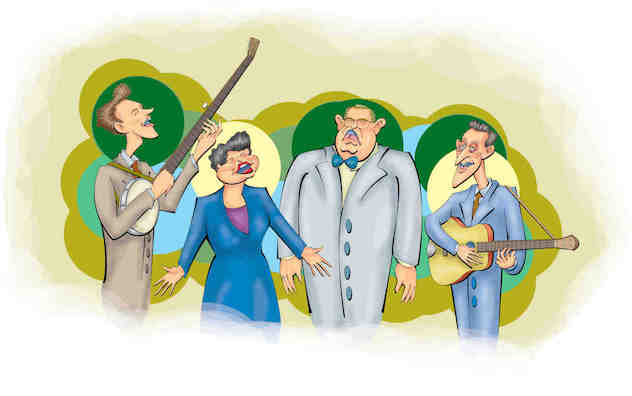
The Weavers
Pete, Ronnie, Lee, and Fred
One thing that that differentiated Huddie was his age. Most of the folk singers were in their twenties or younger. In 1937, Woody was 25, Lee Hays was 23, and Alan Lomax was 22. Sonny Terry was 26, Josh White was 23, and Brownie McGee was 22. Pete Seeger was a mere 18, and his later co-singers of the folk group The Weavers, Ronnie Gilbert and Fred Hellerman, were 11 and 10 respectively. Huddie though was nearing fifty which to the young bunch seemed ancient.
And there was his background. No matter how much it might have irritated him to be reminded of it, everyone knew that Huddie had spent time in prison and for homicide. The younger folkies, who grew up being entertained with Westerns and crime stories, thought it was pretty cool talking to an actual bonafide and real-life murderer.
Being in New York was also to be at the center of the new radio industry. Huddie continued to appear regularly on the radio and the producers noticed something about him that was not always typical of other singers of the of Folk Revival.
Huddie came to the studios always dressed neatly in a suit and tie, not a faded worksheet and torn bluejeans. Rather than slinging his guitar on his back which a lot of folk singers thought was cool and proletariat, Huddie carried his Stella in a case. He once chided Brownie McGee for not following his example.
But most of all the producers and hosts noted Huddie's professionalism and reliability. He was always punctual and understood the time constraints of a radio program and the need to follow the instructions of the directors. Henrietta Yurchenco, who hosted a folk music program, found that Huddie was a joy to work with. For a short while, Huddie even had his own show.
But the monkey wrenches kept being thrown. In 1936 John Lomax had completed his song book for MacMillan. With Alan credited as the transcriber, the book was released as Negro Folk Songs as Sung by Lead Belly.
Immediately came up another issue. Just whose songs were they?
Note that John did not claim the songs were written by Huddie. And indeed many of them were from the oral tradition and sung by many singers. On the other hand John said they were AS sung by Leadbelly. So the songs were at least based on Leadbelly's arrangements.
Copyright issues regarding folk songs are complex. Some "folk songs" are in fact not as old as you think. "Where Have All the Flowers Gone" was recorded by the Kingston Trio in 1961. They thought it was a traditional tune and it was so labeled. They were mighty surprised to learn it had been written by a 36-year-young Pete Seeger in 1955. They begged Pete's pardon and made sure to credit Pete on later releases.
In fact in the original contract with MacMillan, the rights to the songs were assigned to the publisher. Strictly speaking, then, Huddie couldn't perform, much less record the songs without paying royalties. And this also meant radio stations and theater owners would be reluctant to get embroiled in performances where the ownership of the material wasn't clear.
The truth is that Huddie probably had no input in drafting the contract, and indeed he may not have even seen it. But now he was learning about the niceties of the performing arts. Eventually MacMillan gave in a little but not much. They insisted on keeping to the original contract but would separately grant Huddie permission to sing the songs royalty-free.
Long after Huddie was dead the copyright claims were still an issue. In the 1990's Alan was interviewed on the radio and the topic of the copyright of Huddie's songs was broached. Alan actually became flustered - something that rarely happened - and he had trouble articulating an answer.
For the next few years, Huddie remained mostly in New York performing for folk functions which included union meetings and rallies. He would appear with others singers including Woody Guthrie. He and Woody actually sounded pretty good together.
All in all Huddie seemed to be mellowing out. Some of his last recordings were of him sitting with Martha and some friends singing songs and talking of his past. His soft-spoken narratives are a contrast to his powerful vocal style.
But there was one incident that harked back to the old days. In 1939 Huddie was arrested for stabbing a man. As in all stories about Huddie's arrests no one knows what really happened.
One story was it was because a man was caught climbing through the window of his apartment. Alan Lomax said he thought the problem was that another man had been paying a bit too much attention to Martha. The two scenarios are not mutually exclusive but in any case Huddie was arrested and charged with felonious assault for stabbing a man sixteen times.
Alan helped gather the money to post bail. But ultimately Huddie ended up serving eight months on Riker's Island.
The year 1940 was the defining year of the Folk Song Revival. This was when it seems everyone who was anyone showed up in New York: Woody Guthrie was there as was Pete Seeger, Burl Ives, Lee Hayes, Josh White, Sonny Terry, and Brownie McGhee.
Huddie was still getting publicity and RCA - the big name record company - issued an album which once more didn't sell very well. Huddie then went down to Washington where Alan recorded some of his songs for the Library of Congress.
But by the the end of 1941 the folk scene was broken up. There was, after all, a war on - World War II. Huddie, of course, was over fifty and not expected to be called up by the military. But how he would fare in the upcoming conflict was uncertain since the country at war had little time for folk music.

Moe Asch
Good for a five spot.
On the other hand, it was also in 1941 that Huddie began recording for the now legendary Moe Asch who later would launch the Folkways label. Moe was interested in recording folk music and making it always available and was less concerned on how many recordings he sold. But his recordings of Huddie did well enough for him to release a steady stream of albums. He gave Huddie the standard 2¢ per record royalty deal but Moe was always good for a five or ten spot if Huddie needed it.
Moe's business was always run on a shoestring budget and so he was often a bit behind in his royalty payments - that's putting it mildly. Fortunately, Martha and later Huddie' niece, Tiny Robinson, would sometimes stop by with a gentle reminder.
In 1944, Huddie had been mentioned as a possibility to take the role of The Lord in the movie Green Pastures, the first feature-length Hollywood movie to have an all black cast. Although the part never materialized for Huddie, he decided to go to Hollywood and see if he could find new venues for his talent.
By now Huddie had experience in acting as his own manager. Almost as soon as he got to California there was an article about him in the People's World. Also and by good luck Huddie bumped into Tex Ritter on the streets of Los Angeles. Huddie had met Tex in New York through John Lomax. Tex was a big country star and when he greeted Huddie he said he should go to Capitol Records. Rather than arrange a formal audition, Tex invited one of the executives to his home to hear Huddie play. Huddie left that night with an agreement to cut an album.
Technically the Capitol recordings are among the highest quality of Huddie's records. However, they also had other instrumentation backing him and the songs aren't always typical Leadbelly. But they're worth hearing.

Gene Autry
Huddie was a fan.
Huddie was able to find work up and down California from San Diego to San Francisco. He played concerts and performed at clubs and on the radio. He also met one of his favorite singers who had made it big in the movies - Gene Autry. But for Huddie, no movies ever panned out.
After World War II Leadbelly had began to draw both respectable fees - a concert could bring in $200. Still he never seemed to be able to clear much more than $1000 in a year. Traveling did have its costs and New York was getting expensive.
In 1949 Huddie went international and he performed in France. It was quite a change to be in a country where segregation was illegal and he could walk into any restaurant or go into any theater and sit where he wanted.
But before he returned to America, Huddie had a spell where he found walking difficult. The symptoms lessened and he was able to continue performing. But a French doctor diagnosed amyotrophic lateral sclerosis, ALS, usually called Lou Gehrig's Disease.
Huddie's last concert was at the University of Texas at Austin in July 1949. Fortunately it was recorded and issued as an album. In the last few months he was unable to perform and he died in December, 1949.
The irony is that Huddie's favorite song, "Irene" became the #1 hit on the pop charts the next year when it was released by The Weavers albeit in a rather sanitized version. Today Leadbelly's version would raise no eyebrows. But things were different in 1950. So instead of Leadbelly's line:
I get you in my dream.
... we hear:
I'll see you in my dream.
And the Weavers also sing:
Sometimes I get a great notion
To jump in the river and drown.
... but left out Leadbelly's final verse:
If Irene turns her back on me
I'm going to take morphine and die.
But Leadbelly really hit the big time with the third Folk Revival. This started in 1958 with the hit song Tom Dooley by the Kingston Trio. Suddenly folk music was cool (and profitable), and a TV show, Hootenanny hit the air on ABC from 1963 to 1964.

Henry
The Weavers
"Irene" was a hit.
Moe Asch found his records now in more demand than ever. Record shops started putting in bins with Leadbelly's Folkways albums. Then with the rise of the CD you could get Leadbelly albums, now reissued and remastered, in every town and hamlet. And of course today Leadbelly is only a click away.
References and Further Reading
The Life And Legend Of Leadbelly, Charles Wolfe and Kip Lornell, HarperCollins, 1992, Da Capo Press, 1999,
"Ledbetter, Huddie ("Lead Belly") (1888-1849)", Jan Harold Brunvand, American Folklore: An Encyclopedia, Taylor & Francis, 1996, 2006.
"Lead Belly", Laurie E. Jasinski (Editor), Handbook of Texas Music, Texas A&M University Press, 2012.
"Leadbelly", Audio Recordings, Library of Congress.
"Angola Prison (Louisiana State Penitentiary)", Novelette Brown, The New Encyclopedia of Southern Culture, University of Carolina, 2011.
"The Story of Angola", Michael A. Kroll Still Life: Inside Southern Prisons, Winter, 1978, Vol. VI, No. 4., The Institute for Southern Studies.
Scottsboro Boy, Haywood Patterson (with Earl Conrad), Doubleday (1950).
Worse than Slavery: Parchman Farm and the Ordeal of Jim Crow Justice, David Oshinsky, Free Press (1997).
"Slavery Was Accepted as Normal in the Ancient World", The Romans.
"Lead Belly", William Ruhlmann, AllMusic.
"12-String Guitar: From the Street to the Stage", John Bogdal, StringJoy, August 9, 2017.
Folk Songs of North America, Alan Lomax, Doubleday, 1960.
"The Last Folksinger", David Browne, Rolling Stone, October 10, 2019.
"The Jeter Plantation", leadbellyhuddie.blogspot, November 29, 2018.
"Blood and Sugar", Michael Hardym Texas Monthly, January, 2017.
"Leadbelly", Edward M. Komara, Encyclopedia of the Blues, Psychology Press, 2006.
His Excellency, Joseph J. Ellis, Vintage, 2004.
"Tom Hughes", Mike Miller, USGenWebFile Archive, 1999-2000.
Rate Your Music.
Measuring Worth.
"Who Owns Folk Songs?", Paul Race, Creek Don't Rise.